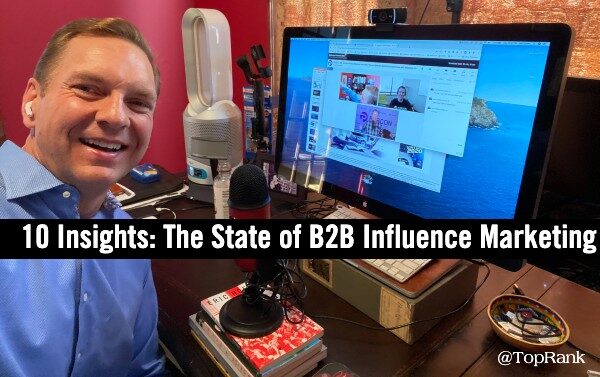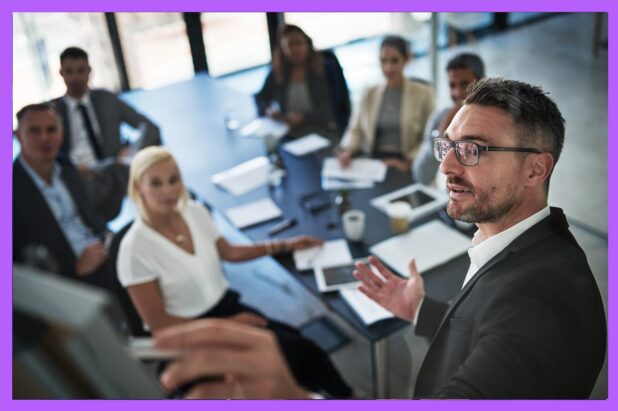
What does the state of B2B influencer marketing look like now and in the future? How can B2B brands start a successful influencer program? Why is it more important than ever to approach B2B influencer marketing with an always-on influencer strategy?
Many of these questions are answered in the 2020 State of B2B Influencer Marketing Report and yet we all know the complexity and opportunity combination of influencer marketing requires further exploration. Luckily Jason Falls connected with our CEO Lee Odden for a podcast interview to explore the answers to these questions and more, along with his most recent B2B influencer marketing insight.
After listening to the podcast, I’ve pulled out 10 of the most compelling insights about the state of B2B influencer marketing to help inspire your success in 2021 and beyond.
1 – B2B Influencers Are Credible Voices Throughout The Customer Lifecycle
B2B purchases are a journey, and there is a long cycle of education and content consumption that occurs as brands or buyers educate themselves about possible solutions and how they might work for their company.
When you talk about end-of-funnel activities, where you’re looking for increasing purchase intent, increasing order volumes, and acceleration through the sales cycle — things like that — the explicit advocacy of a subject matter expert in the form of an industry influencer can definitely facilitate these.
The credible voices of B2B influencers play a role throughout the entire customer life cycle.
It’s important to identify the topics of influence that are representative of how the brand wants to be known — topics that customers actually care about — and find the people that can represent those ideas and values.
“The credible voices of B2B influencers play a role throughout the entire customer life cycle.” @LeeOdden Share on X2 – Digital Influence Is Heightened During The Pandemic
The ability to influence doesn’t just exist in a digital world, but with the pandemic, for B2B it’s more digital now than it ever was before. There are opportunities now to connect with people who may be more offline influencers, however the bulk of digital marketing that’s occurring in the B2B space is online, and the signals of credibility that people are using to determine whether someone is relevant or interesting to them tend to be digital.
A holistic approach is important, including the use of tools, including Traackr, which is both a B2C and B2B platform. A tool is only as effective as the expertise of the person using it. It is up to the expertise of the users as much as it is about the platform, because the data is agnostic in terms of B2C or B2B — people are either publishing or they’re not.
The content they’re publishing is either topically relevant or it’s not, and the topics they are publishing are either resonating or not. These can be identified by engagement activities, and by whether messages are propagating and being shared or not.
“A tool is only as effective as the expertise of the person using it.” @LeeOdden Share on X3 – Identify Core Characteristics Of Influence Around A Topic
We can identify core characteristics of what makes a person influential around a topic of influence, partially through the use of the appropriate software. There are however lots of other steps to consider — manual inspection of the content that influencers are publishing, the cadence of publishing, and certain background information that should be taken into consideration before recommending them to a client. They have to be doing what your brand is talking about to determine whether an influencer may work or not.
Influence is not permanent — it’s temporal. While at the moment of identification a person may be very influential about a topic, will they always be influential about it? Maybe, or maybe not, and on top of understanding the key performance indicators (KPIs) being delivered on for the campaign, or for the influencer engagement activity, you’ve also got to be able to report on the effectiveness of what is being done.
“Influence is not permanent — it's temporal.” @LeeOdden Share on X4 – Understand The Conversations Being Driven By Influencers
Are we moving the needle or not? Are we reaching those business outcomes that we’re after, and at the same time we have to identify — through tracking URLs and other metrics available via influencer marketing platforms and web analytics — whether or not, or the degree to which an individual is effective for a purpose.
You can certainly look at data from social media monitoring tools such as Brandwatch, Agorapulse and others, to monitor various topics and hashtags, and Keyhole is another useful tool for hashtag and handle tracking. They offer an on-demand way to understand the conversations being driven by influencers, as they share social messages and the content they help to make.
At the same time, you have to be accountable as in any campaign, and you’ve got to report upstream to the stakeholders in the organization things such as, “Okay —here’s our goal, and here’s what we achieved.” There are real-time metrics and things that help you optimize in an ongoing way. There are also campaign metrics that determine the effectiveness of a program, and that may ultimately help decide whether you keep someone or sunset them and replace them.
5 – Use The Right Influencer Ingredients For Your B2B Recipe
Everyone is influential about something, as Lee often points out, and all of us both influence other people and are influenced by others on a daily basis.
When we take this holistic view, it’s like we’re a chef in a kitchen with a recipe, and we have ingredients and there are different types of influencers that can make a very effective campaign. If you’re making a stew, you know that potatoes are one ingredient — and that’s your brandividual — the famous person you’re going to use to attract others.
However you’ll also want to go after reach influencers, internal subject matter experts at the brand and perhaps some of their customers, along with other niche experts that are out there in the field that are practicing in their particular area — people who their friends would go to if they needed help or if they needed advice. You want to bring all these different ingredient voices into a campaign and architect and build a recipe highly appropriate to what the audience will find delicious.
“Everyone is influential about something.” @LeeOdden Share on X6 – Achieve Affinity & Elevate Brand Perception With Influencers
It’s so much more than just a tally of fans, friends and followers and whether a person is famous — there are different types of influence. This is something to consider as you become more sophisticated in B2B influencer marketing.
It’s more about what they are and how they are using influencers than merely what they’re good for. A lot of B2B marketing investment you think of as overwhelmingly focused on the end-of-sale-cycle type of activities. However, they’ll never get there if they don’t achieve affinity, if they don’t achieve connection and engagement before that. If they’re not ever considered, they’ll never make it to the sales conversation. A lot of the top and middle of funnel activity is where a great deal of demand generation activity is happening.
At the moment that’s where a lot of B2B marketers are investing in influencer marketing — to elevate brand perception, to warm the market and increase consideration. Ultimately they will also get to that point-of-sale conversation as well.
“A lot of the top and middle of funnel activity is where a great deal of demand generation activity is happening.” @LeeOdden Share on X7 – Recognize B2B Influencer Marketing’s Sales-Generation Potential
B2B is different from B2C, in that with B2C it’s fine if you have a person explicitly advocating for a product — it’s often what people do — they hold up a bottle of soda or face cream or whatever it may be and ask people to buy it to look beautiful.
In the case of B2B, however, if you have someone explicitly endorsing a product like that — for something that can often take six months to two years as a sales cycle — and you have someone explicitly endorsing it, that can come across as not so believable.
To some degree that’s why there aren’t more B2B marketers using industry influencers specifically for sales generation. There are however quite a few interesting anomaly types of case studies where millions of dollars in revenue was generated by working with influencers, however this isn’t the norm just yet.
8 – Overcome The Fear Of Getting Started In B2B Influencer Marketing
In some ways there’s both so much and so little confidence in B2B influencer marketing at the same time. 96 percent of marketers believe that engaging influencers consider their programs to be successful, according to our recent groundbreaking 2020 State of B2B Influencer Marketing Research Report.
We have that on the one hand, yet the other hand, 60% say they don’t have the knowledge to execute or have the right skills in-house to implement ongoing influencer marketing programs.
This isn’t exactly an apples to apples comparison, however, because one is just broadly about influencer marketing, and the other has more to do specifically with ongoing, always-on efforts, which tend to be more successful.
9 – Benefit From The Advantages of Ongoing Influencer Programs
Only 19 percent of companies are implementing ongoing influencer marketing programs, however 60 percent of marketers who use always-on influencer marketing programs consider themselves very successful, versus only 5 percent who do traditional periodic campaigns.
This means that 12 times more marketers who use always-on say they’re very successful than those who just do periodic campaigns.
B2B influencer marketing is without a doubt a relationship business, and this means developing genuine relationships, where through the exchange and through the experience a brand is creating for the influencer, that influencer is getting value and getting exposure.
Sometimes they get paid, and all the while they’re also learning more about the brand and growing closer to the brand.
10 – Learn From Successful Influencer Marketing Programs
Our client Adobe has an influencer program called Adobe Insiders, and Lee is a member of the program.
He’s seen the program from the inside and found it to be incredibly effective with the relationships that Adobe has invested in and developed among their community of influencers.
Many, without even being asked, are publishing to business publications like Forbes, Inc., and other publications, just because they have this love for the Adobe brand.
There’s no doubt that it’s a very beloved brand anyway, but the fact that Rani Mani, the head of global influencer enablement at Adobe, is such a charismatic personality and pays so much close attention to personalized communications with the people that are part of this community and creates a platform for them to connect with each other has a great deal to do with its success and what a powerful community the Adobe Insiders have created.
Find out more about Rani and the B2B influencer marketing advantage in our recent Inside Influence video interview with Lee, in “Inside Influence: Rani Mani from Adobe on the B2B Influencer Marketing Advantage.”
Learn More About Ascending To B2B Influencer Marketing Success
We hope these 10 B2B marketing insights and tips from Lee’s conversation with Jason on the Winfluence influencer marketing podcast have been helpful, and that they’ll inspire and bring newfound success to your own efforts.
You can listen to Lee and Jason’s complete interview on the Winfluence podcast here.
If you’re among the 60 percent of B2B marketers who feel they need help to execute an ongoing influencer marketing program, contact us to get started with B2B influencer marketing, and find out why brands from SAP, LinkedIn, and Adobe to IBM, Dell, Cherwell Software, monday.com and more have chosen TopRank Marketing.



